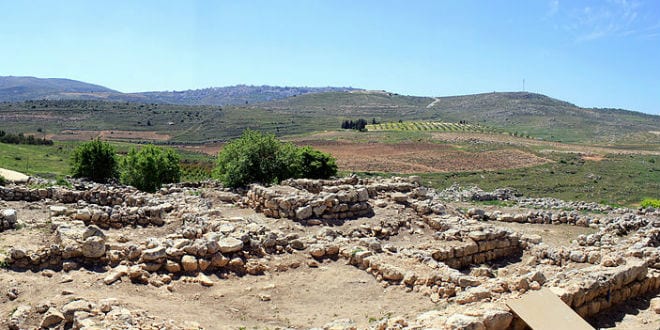When you visit Israel, it doesn’t take long to feel how alive the Bible is here. Around every corner, there’s a place mentioned in the Torah (Hebrew Bible)—a location tied to the stories of our ancestors. Some of these sites are well known, others quietly tucked away—but each holds a powerful piece of our history. One of the places I feel especially privileged to show tourists is Tel Shiloh, just North of Jerusalem, nestled in the peaceful hills of biblical Samaria which for 369 years was the spiritual center of the universe. It’s where history, faith, stunning views, Geo-politics and well-preserved ancient ruins come together in a deeply moving way. This place also ignited a revolution in prayer practices, establishing a model that remains the gold standard for how Jewish people connect with G-d. Come with me as we journey back in time to this sacred and unforgettable place.
Shiloh sat along the ancient Route of the Patriarchs—what’s now Highway 60—Biblical Israel’s main north-south artery. This key route connected major cities of Judah and Samaria like Jerusalem, Bethlehem, Hebron, Bethel, Shechem, and Beersheba—the region where about 80% of the Bible’s events took place. Shiloh’s prime location may be one reason G-d chose it as the central gathering place for the Jewish people for centuries.
As a tour guide, I often get the question, “How do we know this is the place?” When it comes to Shiloh, the answer is surprisingly straightforward. Archaeologists had a clear lead because the Bible gives us its exact location. In Judges 21:19, it says:
“Behold, there is a feast of the Lord in Shiloh… which is north of Bethel, east of the highway that goes up from Bethel to Shechem, and south of Lebonah.”
With such specific directions, identifying ancient Shiloh on the modern map was one of the easier tasks in biblical archaeology (we will soon see in part 2 that there is another crucial find which verifies this special location)!
Long before Shiloh became the spiritual heart of Israel, it was a fortified Canaanite city, established around 3,800 years ago—right around the time of Abraham. The Canaanites built strong defensive walls here, much of whose ruins are still standing today for visitors to see with their own eyes.
As you stand atop the ancient site of Tel Shiloh, it becomes immediately clear why this place was so cherished in biblical times. More than just a stop along a central highway, Shiloh was blessed with rich, fertile soil—ideal for growing grapes and olives, two of the Land of Israel’s most iconic crops. Remarkably, the same bounty continues today: the surrounding hills are still blanketed with vineyards and olive groves, echoing the agricultural life that once thrived here during the time of the Mishkan (Tabernacle). It’s a powerful reminder that the land’s blessings have never ceased, just as foretold in the blessing Jacob gave to Joseph—whose son Ephraim inherited this very territory—describing a land rich with the “sweetest yield of the sun” and the “best prneoduce of the ancient mountains” whose “land shall be blessed by G-d” (Deuteronomy 33:13–15).
Of course, when the Jewish people eventually settled in Shiloh, this location was not selected merely because of its convenient location on a major trade route or bountiful fields. Rather this place it was chosen by G-d as the first long-term resting place of the Mishkan (Tabernacle) after the Israelites entered the Land (see Joshua 18:1).
After 14 long years of battling the Canaanites, the Israelites were finally nearing the fulfillment of their mission: to reclaim and settle their eternal homeland. Yet, despite all the progress, seven of the twelve tribes had still not received their designated portions of land.
To move forward, Joshua instructed these tribes to survey the remaining territory and return with detailed reports to Shiloh. The plan was to divide the land by drawing lots under divine guidance, and then continue the process of conquest and settlement.
But before any land was measured, divided, or conquered, one crucial act came first: the Israelites built the Tabernacle in Shiloh (see Joshua 18). According to Jewish sources, this sequence is deeply meaningful. The verse’s emphasis on erecting the Tabernacle before the land was fully subdued highlights the true purpose of the conquest. The land wasn’t given to the Jewish people simply as a place to live—it was given to them to create a spiritual center, a home where God’s presence could dwell among them. With the establishment of ‘G‑d’s home’ on earth and the division of the land by lot—formally designating Israel as the eternal homeland of the Jewish people—a spiritual revolution was underway, one that continues to profoundly influence world politics and religion to this day. Also, this set the stage for some of the most dramatic biblical events in history.
-To Be Continued…
For a sample tour itinerary which can include experiencing biblical Shiloh, click here. To view his sample Gaza Envelope tour itinerary, click here.
Nosson Shulman is a journalist and Licensed Tour Guide in Israel specializing in Biblical tours. To allow tourists to experience Israel during the Corona era, he created the new hit Israel tour video series which brings Israel to the home of viewers by simulating actual tours. To check out his free sneak preview tour videos, click here. To view sample tour itineraries or to inquire about private tour opportunities with a personalized itinerary on your next trip to Israel, click here.






